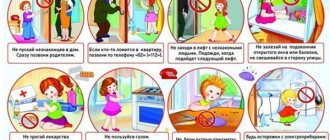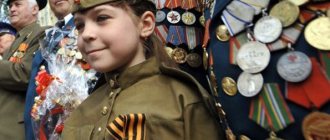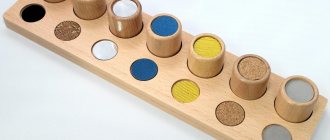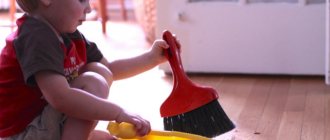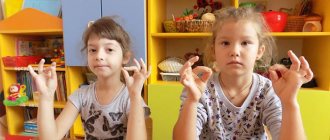"Ladybugs"
Material: cards with the image of ladybugs with a number on the left wing; numbered cards for the second wing; numbers in circles.
Options for using the guide:
1. The teacher places a number in a circle above the ladybugs and invites the children to choose a number for the second wing. The child finds this number and attaches it to the wing.
2. The numbers are located on both wings of the ladybugs. The child needs to make a number from two numbers and find the corresponding number in the circle.
"Amanita"
Material: fly agaric caps are double-sided: white dots are glued on one side (from 1 to 10, on the other - examples; fly agaric paws with numbers from 1 to 10; white and red circles.
Options for using the instructions: 1. “Choose a stem for a hat from a fly agaric”: the task is considered completed correctly if the number of points on the hat matches the number on the stem.
2. “Solve examples”: you need to solve arithmetic examples (on the lid of the fly agaric) and find the answer (the number on the leg of the fly agaric). The task is considered completed successfully if the arithmetic example is solved correctly.
“Equal - unequal” The presenter casually places his feet on the fly agaric caps. Often the numbers on the legs do not correspond to the number of points on the caps. The child must match the number and number of points using double-sided counters. To do this, he covers the extra points on the hat with the red side of the chip and adds the missing points with the white side of the chip. The task is considered correctly completed if the number of points on the hat matches the number on the leg.
"At home"
Material: Houses with windows. There is only one room on each floor. Set of numbers.
How to play: The number on the roof indicates the number of inhabitants on each floor. The child must select and enter a number in the second window.
“Match the wheels to the car” Options for using the guide:
1. The car is given a number. Children must match the wheels to the car so that the number of dice on the two wheels, indicated by the numbers, is the number shown on the car (select all options).
2. Numbered wheels are placed on the car and the child must determine the total number of wheels and put the corresponding number on the car.
"Polyanka"
Material: Polyanka (in green cardboard); 2 types of box colors; Velcro in the center for fixing numbers on the clearing.
How to play: A number is placed in the center of the clearing. The child must make this number from flowers of different colors.
Admission to school
At the moment, there are no official requirements for a child in terms of skills and abilities when entering first grade. However, at almost every school and every children's club there are courses for preparing first-graders. In kindergartens, the last year of study is also combined with the period of preparation for school. In order to get to a good teacher at the best school, a child upon admission must be able to read, write basic words, add, subtract and reason. Mastering these skills can be entrusted to teachers, but you can also master the necessary training yourself with your child.
Mathematics Requirements
A child masters counting on average at four years of age. By this age, he is able to count objects and name their quantity. By first grade, the child should also be able to add numbers in his head within ten. Be able to write these numbers and subtract them. In addition, the preschooler must know the composition of the number. How to explain the composition of numbers to a child? Actually, it's not that difficult. The composition of a number is at least two numbers, the addition of which results in the original number. How to explain the composition of a number to a child? First, you need to understand this definition yourself.
Activities with number cards
Number cards are pictures where the number of objects corresponds to a certain number.
It is with these cards that it is best to start getting acquainted with the composition of numbers, because this method is visual and more accessible. Here is an example of such cards:
First, you should explain to your child what addition is: adding another to one number, we get a third number. This is best demonstrated on small objects (candies, buttons, pebbles, pencils, etc.) or cards: for example, on one there are 2 bananas, and on the other 3 oranges. If you add them together, how many fruits do you get? The child counts all the fruits and names the amount. At the same time, he gradually remembers how much it will be if you add up certain numbers.
Once you have an understanding of the process of adding different objects, you can take on the composition of a number. The adult names the number of items that should be obtained in the end, and together with the child they collect different combinations. It is better to start with small numbers and gradually increase.
For example, you need to collect 4 apples. We offer the child a card with only 1 apple drawn and ask which one else needs to be chosen so that there are 4 apples in the end. Then we take a card with a picture of 2 apples and ask the same question. Thus, all possible combinations are tried.
Gradually you can move on to larger numbers, where the number of combinations will increase. With repeated repetition, the composition of each number is stored in memory and then reproduced mechanically.
Composition of numbers on sticks
How to correctly explain the composition of a number to a child? You can use ordinary counting sticks. They are sold at any office supply store. For example, how to explain to a child the composition of the number 5? You need to take five sticks. Preferably one color. Out of five sticks, put one aside and count the remaining ones. It turns out four sticks and one. Here are four and one - this is the composition of the number five. Next, you should add another stick to one stick. It turns out three sticks and two. Thus, three and two are also a composition of the number five. Next you should move another stick. It turns out one and four. This is also a composition of the number five.
How to explain to a child the composition of numbers: option two
You can take a piece of paper and a pen. How to clearly explain to a child the composition of a number with their help. You can write any number on the piece of paper. For example, seven. You must write in the middle of the line. From seven you need to draw two arrows down. Under one write the numbers from one to six. Under the other - the same thing, but in reverse order. You will get two columns with numbers. Opposite the six there will be a one, opposite the two there will be a five, opposite the three there will be a four and so on. An addition sign should be placed between the numbers. It will clearly become clear that seven consists of the sum of one and six, the sum of two and five, three and four, and further down the list. In this simple way, seven becomes decomposed into two numbers, the sum of which gives the original value.
Number houses
Houses with numbers are the next step in learning the composition of numbers. They are a building with a roof and two apartments on each floor. There is always a number on the roof that splits into two others that live next door to each other. The number of floors depends on the number of possible combinations: the higher the number, the more options for laying it out and the higher the house.
To understand the composition of a number with your child, just draw such a house. For example, for the number 3 it will have 2 floors, on which 0 with 3 and 1 with 2 are adjacent
Having explained the main principle, you need to give children the opportunity to fill out the number houses on their own: leave them empty and indicate only the number on the roof, the composition of which must be distributed among the floors. You can start from the bottom floor or from the top.
If the task is difficult, you can fill in some of the boxes as a hint. But in the future it should be explained that each number, moving from one floor to another, becomes 1 more or less. And if in one apartment there is a decrease of 1, then in the next one there will be an increase of 1.
After the compositions of numbers up to 10 have been mastered, you can move on to the second ten, if the child is familiar with it.
How to explain to a child the composition of numbers up to 10?
The option with a house is also very suitable for explaining. How to explain to a child the composition of numbers using this technique? You need to draw a house on a piece of paper. In the triangular roof you need to write the number ten. The main part of the building must be divided into two halves vertically. Next, the house must be divided into ten floors. In the resulting left column you should write the numbers from zero to ten, in the right column, respectively, in the reverse order. It turns out that on one floor there are zero and ten adjacent, on the next - one and nine, then - two and eight, and so on. Such houses are very visual and can be made for any number up to ten. More is possible, but it is not advisable.
You can draw houses together with your child. You can decorate them or even make them with applique. Here everyone is guided by their imagination. These images can be taken with you to school or preparatory classes. An interesting option for making a house would be a craft with opening windows. It is a little more difficult to make, but the child will perceive this method of explanation as an exciting game.
To begin, you will need two identical sheets of paper. One shows a house with floors. An opening window is cut out in each of them. This sheet with the image of the house should be glued to the second sheet. You have to be careful here. The windows should not be glued to the second sheet. In each box you should write the required number. The windows can be closed. The child must himself remember the number hidden in the window.
How to teach a child the composition of numbersconsultation (preparatory group)
Starting to learn and study numbers and counting, the child is faced with the concept of the composition of a number. Many parents do not think about it and do not pay attention to this when they are memorizing sequences. However, studying the composition of numbers will speed up memorization, as well as the child’s understanding of the principle of number formation.
When should you start explaining to a preschooler what the composition of a number is?
At the age of 5-6 years, children already know numbers well and become familiar with simple arithmetic operations. It is during this period that it is worth spending a little time on exercises and explaining to the child the composition of numbers up to 10. However, it is important that the child has already mastered:
- direct verbal counting to 10;
- count down from 10 to 1;
- recalculation and counting of objects;
- composition of a number by units (for example, 2 consists of 1 and 1, 3 – of 1 and 1 and 1).
All these skills indicate that the child can already explain the composition of any number within 10.
What is useful for homework?
Classes will become more effective if you prepare in advance and collect the necessary training material:
- counting sticks;
- game cubes;
- cards with images of numbers;
- multi-colored pebbles or buttons;
- abacus;
- houses for numbers.
You can purchase ready-made educational kits at stationery or toy stores, or make all the necessary items together with your child. The second option is preferable.
Effective techniques
The composition of the number 10 needs to be explained gradually, dividing the training into several logical blocks. In the first lessons, you should pay attention to the numbers 2 and 3, their relationships and possible combinations. Then you can move on to classes with visual cards and only then connect number houses.
Lesson 1: mastering the numbers 3, 2, 1
Take your baby's favorite toys and things (blocks, dolls, cars). Start the exercise by analyzing the number 2 and show your child how it can be obtained:
- Place one object on the table in front of the baby and ask the child to make it become two. Usually it is not difficult for him to figure out how to cope with the task. If necessary, give a hint.
- Explain to your child that 2 is a number that always consists of a pair of ones.
- Ask your child to place 2 of their favorite items on the table.
- When the two is fixed, move on to studying the three. Tell your child that if you add 1 to 2, you get 3. Place two coins in front of him and another one next to him. The child must learn that there is no difference between 3 coins together, 2 with 1 or 1 with 2.
Gradually make the task more difficult. Getting a four in a game is as easy as getting a three. Chess or checkers can help here. Invite your child to choose 2 shapes of the same color (white), and then repeat the task. Ask: How many chess pieces will remain if 1 light chess is replaced by 1 dark one? What happens if you combine 2 black and 2 white pieces? In the end, he should understand that the number 4 can be obtained with every possible permutation.
It is worth moving on to the next block of tasks when the child understands that all these actions will lead to a result known in advance:
- 2 is 1 + 1, 2 + 0;
- 3 is 2 + 1, 1 + 2, 3 + 0;
- 4 is 1 + 3, 2 + 2, 3 + 1, 4 + 0.
Using the same principle, explain the remaining numbers up to 10.
Task 2: number cards
At this stage, the child should already understand that by adding different numbers, you can get any result. But when you need to find out the composition of a certain number, you need to go from the opposite - from a predetermined answer. You need to work with him to sort out all the pairs of terms that lead to a single result. Number cards are great for this. There are several training options:
- Draw, for example, 5 butterflies on the cards and invite the child to collect the required number from the proposed blanks.
- Invite him to collect combinations on his own several times, in which their total will ultimately be equal to 5.
- Ask your child to tell you how to get a number. Make mistakes, kids will have to use all their abilities to figure them out.
You should begin the last block of tasks when the child can select all the options for the composition of the specified number.
Task 3: number houses
Arithmetic houses are great for helping to finally understand and consolidate in a child’s knowledge the concept of the composition of any number, as well as to develop the skill of mental calculation.
A house for numbers is a building with a roof and several floors with apartments in two rows. The height of the structure depends on the number to which you need to select all possible combinations of numbers. To explain to a child the composition of the number 2, it is enough to draw a house with two floors (0+2, 1+1) and so on.
House blanks can be found in mathematics textbooks or you can make them yourself from cardboard.
How to structure a lesson:
- Place an empty house on the table, placing a card with a number from 2 to 10 (let it be 6) in its roof.
- Explain to your child that on each level there are as many people in the apartments as are written on the roof.
- Set the condition: only one person lives in 1 apartment on the ground floor. The kid needs to think and determine how many residents live in apartment number 2 (the correct answer is 5).
- Now that the algorithm for solving the problem is clear, ask the child to populate all the remaining apartments, changing the initial number of residents on each new floor. As a result, there will be 2 and 4 residents on the 2nd floor, 3 and 3 on the 3rd floor, 0 and 6 on the 4th floor. Thus, the baby will be able to master all existing combinations of numbers.
A small life hack: tell us that any number always consists of 1 and the previous digit in order. So, if you want to find out the composition of the number 7, the first answer is immediately ready: 7 is 1 and 6.
When all pairs of numbers and the composition of 10 are mastered, you can complicate the tasks.
Exploring the twenties
If you managed to explain to your child what the mathematical composition of a number is, then you should move on to one of the most difficult moments - working with tens. The kid will definitely ask why 6+5=11, which is why it is called and written like that. First of all, tell us that for convenience, large numbers are counted as tens. For example, 6 and 4 are one ten. Since the problem required adding 5, and we have already added 4, then only one is missing. Therefore it turns out:
- 6+5 is 6+4 and 1 more;
- 6+4=10;
- We write the last unit instead of 0, it turns out 11.
At first, the child will not understand anything, but after a while he will learn the basic principle of working with tens. You can make the problem easier with a visual exercise:
- ask to count out 10 candies and put them in one bowl;
- now you need to put 7 more treats in another container;
- under each bowl you should place a card with the image of a number corresponding to the number of candies;
- ask your child to add everything together and tell him how many candies he got;
- for better understanding, explain that 10 in two-digit counting means 1;
- correct option: the child writes one and 7 next to it, which means 17.
Similar examples can be carried out with a large number of objects. For example, a preschooler should know that 32 is 3 tens plus 2 more units.
How to help a child?
Numbers from 2 to 10 are very common in everyday life, and learning to count is largely a creative process. It’s easy to help with mastering numbers even without purchasing special devices:
- Does your child like sports? Count the number of goals scored with him.
- Does your child love nature? Look at the trees on the lawn, compare on which side there are more of them and on which side there are fewer.
- Does your child constantly draw something? Invite him to draw a certain number of objects on the sheet. Are you into sculpting? Ask to make a figurine with 3 legs, 2 tails and 1 ear.
- Be cunning. Throughout the day, ask your child “if I take one cookie from you, how many will you have left?” and the like.
In a comfortable gaming atmosphere, the child will quickly figure out the composition of all the numbers and will count 1 2 3 4 5 and up to ten correctly.
If your baby is not good at mental math, then we can assume problems with thinking, attention or lack of concentration. Games from BrainApps will help you direct your energy in the right direction. The service offers over 100 simulators that allow you to develop and improve your intellectual skills.
capabilities. After registering on the site, select the required category of games:
- To improve memory. Trainers such as “Numeric Spanning”, “Memorize and Click” and “Find a Pair” will develop memory capacity, improve its accuracy and improve attention span.
- To develop thinking. The games “Fruit Mathematics”, “Comparing numbers from memory” and “Moving” will improve visual and spatial memory, develop logic and teach the child to quickly find answers to questions.
- To improve attention. The “Find the Shape”, “Space” and “Concentration” simulators will help your child concentrate better and direct attention in the right direction.
Playing games online with your preschooler is not only a fun, but also a useful hobby. The child will be able to develop, achieve his goals and compete with you or his peers. All you need is a network connection and free time.
Recommendations for parents
Understanding the importance of explaining the composition of numbers, try to adhere to the proposed recommendations that will help your preschooler calmly master and remember new information:
- Everyone has crises, but we must remember that this is a temporary phenomenon.
- Let's have more freedom. Often the parents' demands do not correspond to the child's capabilities. Think about whether all your prohibitions are justified.
- Consider children's opinions. It is necessary to clearly understand that a preschooler has his own opinions and judgments. Try to accept them.
- Forcing is ineffective. Edification and commanding tone during classes will not give a positive effect. If your child doesn’t want to learn numbers and examples with the numbers 1 2 3 seem scary to him, find out what the reason is. Explain why and why you need to study.
- Patience and optimism are your best companions. A good mood, an atmosphere of love, support and mutual understanding direct aspirations in the right direction.
It is also recommended to adhere to a strategy of positive assessment of the baby:
- Show your friendly attitude.
- Find and analyze errors together.
- Discuss options and solutions to errors together.
- Support and express confidence that he will definitely succeed.
Don’t forget to consolidate your results and include educational cartoons and other videos in your training program.
Material selected: internet source
Abacus
Another simple way to explain the composition of numbers is the usual abacus. Now this tool is not particularly popular. This is due to the great availability of electronic computing tools (calculators). However, they can still be seen in small counter-type shops. There are ten dominoes on each wire of the abacus. By moving the dice from one end to the other, you can also visually learn the composition of the number ten. The abacus is also a great way to learn adding numbers from one to ten.
Dominoes and buttons
Dominoes can be used to explain the composition of numbers up to six. You don't have to draw anything, the dots are already marked. The convenience of this method is that with the help of dominoes you can begin to explain the composition of the number much earlier than such a need arises. Almost all mothers play children's dominoes with their kids. Around the age of five, you can safely introduce your child not only to the game, but also to the composition of numbers.
Another handy material for getting to know the composition of a number is buttons or beads. The advantage of the beads is that they look the same. If there are no beads, then you can use ordinary buttons. The principle of dating is the same as using counting sticks. You should buy identical buttons in advance. You can also use what you have on hand at home.
Didactic material for familiarization with the composition of the number of units in the senior group
Nelya Tkachenko
Didactic material on knowing the composition of the number of units in the senior group
Didactic material for knowledge
with a composition of people from the senior group.
SPHERE:
Forming ideas about the composition of the number inside the first bead.
TASKS:
- regulate, -
– ideas about numbers and numbers inside the first bead;
- develop,-
– the idea that all numbers are made of ones;
– the idea that the number of units in different quantities is different;
– attention, visual perception, memory, logical thinking;
– excellent motor skills;
- mention -
– organization;
– concentration;
– interest in mathematical games;
The calculation of the activity of five-year-olds in the process of systematic learning is already objectively perfect. Studying the composition of the number of units in the senior group is preparation for mastering computer technology - counting and counting one at a time.
What else to read: Didactic game “Atelier” (for older preschool children)
The study of the composition of numbers from units should begin with an analysis of the composition of a set of elements to the composition of a number of units, while one should be consistent, not hasty, and from the heel - from each number - from 2 to 5 (2, 3,4,5)
... For illustrative purposes of the material, a group of objects of the same type is selected, each of which differs from each other in qualitative characteristics (for example, color, size) ... In addition, elements that are united by a concept are used in the future, for example, sets of clothes, dishes, furniture, etc. etc. Along with texture elements, you can use patterns of geometric shapes, strips of paper of different lengths and sizes, etc. It is necessary to teach children, when looking at the sets, to tell how this group is composed, to name each element and their total number.
For example:
“The number 4 consists of the following: 1 green circle, 1 red circle. 1 yellow circle, 1 blue circle – 4 circles in total.”
After counting 4 circles, the child must say how it is composed “that’s four”
emphasizing the number of composition: one - green, one - red, one - yellow, one - blue, four in total. When inviting children to do tasks with different types of groups of objects, you should ask them to say how the group is made up, how many different objects there are and how many there are in total, to name both the objects and their number. Gradually you should move from more specific questions to general ones: “How much did you receive? How much... in total? How do you... (for example, 5 pencils?"
When studying the quantitative composition of a number of units, it is necessary to draw children's attention to the fact that a unit can reflect not only an individual object, but can be a reflection of an entire group of objects. For example, invite children to look at a variety of geometric shapes and answer questions:
– What parts does this set consist of? ("Compiled in three parts"
.
– Name the color and number of parts of this set. (“This set consists of three parts of different colors: one part is red triangles, one is blue triangles, the third is green triangles. There are three parts in total.”
– How many units does the number three consist of? ("Of three separate units"
).
In this task, children must understand that a unit can reflect not only an individual object, but also a group of objects.
In the process of familiarizing children with the composition of a number of units, you can use verbal exercises, -
– forest animals gathered in the clearing: a hare, a hedgehog, a squirrel. How many animals are gathered in the forest clearing? How many different forest animals have gathered in the clearing, etc.
And other tasks, for example -
– take five triangles of different colors;
– draw three different geometric shapes;
– put four different dolls on the table, etc.
Familiarization of children with the composition of a number is carried out in a sequential system of classes, which creates conditions for the formation of new connections that form children's knowledge of quantitative composition, which in turn is preparation for computing activities.
What is the composition of the number needed for?
In addition to the fact that the composition is needed for studying at school, it has very important practical significance. With its help, we mentally perform elementary operations of addition and subtraction. The ability to decompose a number into its components allows us to add and subtract within a thousand. Understanding the very principle of decomposition into component numbers is very important in everyday life.
There is even an addition table. It can be up to ten, up to twenty and up to a hundred. These tables are best learned as multiplication tables. Any simple arithmetic operations are based on the decomposition of a number into its composition. Despite the abundance of calculators in the modern world, the need to count mentally still does not disappear. Sometimes the speed of mental arithmetic is faster than the search and use of a computational tool. And memory training never hurt anyone.


